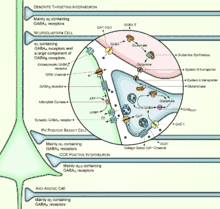Beatriz Rico (neuroscientist)
Beatriz Rico is a professor of developmental neurobiology at King's College London. Her research focuses on neural circuit development.[1]
Early life and education
Rico was born in Madrid, Spain, where she completed her public primary and secondary education. She then attended Complutense University of Madrid to study biology, and earned her Ph.D. at the Autónoma University in Madrid under her supervisor Carmen Cavada.[2]
Following her time in Spain, she completed her postdoctoral research at the University of California, San Francisco under her supervisor Louis Reichardt.[3]
Principal investigator

Rico then formed her own lab focusing specifically on mammalian cortical networks and neurodevelopment disorders.[4] Rico started as a Principal Investigator at the Neuroscience Institute in Alicante, Spain.[2]
In 2014, Rico moved her lab to King's College London where she is a professor of developmental neurobiology and has continued her work on mechanisms of cortical circuit formation.[2] In recent years, her lab has spotlighted the importance of cortical GABAergic circuitry in cognitive function and their potential role in neurological pathologies, especially schizophrenia.[4][5] In 2019, the Rico Lab uncovered a developmental mechanism for specification of inhibitory connections within the brain. Rico worked with Emilia Favuzzi and Ruben Deogracias, who were lead authors of the Science article on this discovery.[6][7][8]
Awards and honors
In 2010, Rico's work received recognition from the European Molecular Biology Organization (EMBO).[1] Additionally, she was awarded Consolidator and Advanced grants by the European Research Council for her project 'Assembly and plasticity of inhibitory cortical networks by early learning experience'.[1][9] This grant was awarded to Rico for research into how early sensory experiences affect efficiency of cortical networks and, ultimately behavior.[4] Rico received a research grant from Wellcome,[10] and she was granted lifelong membership to EMBO's community of scientists in 2021.[11]
References
- "Beatriz Rico, Principal Investigator". Rico Lab. Archived from the original on 2021-03-02. Retrieved 2021-11-29.
- Ribic, Adema (2021-09-17). "Episode 11: Beatriz Rico, PhD". Conjugate: Illustration and Science Blog. Retrieved 2021-11-29.
- "2014 Neurodevelopmental Psychiatric Disorders Faculty". Scienceven. 2014. Retrieved 2021-11-29.
- "Research projects". Rico Lab. Retrieved 2021-11-29.
- Falkner, Susanne; Scheiffele, Peter (2019-05-03). "Architects of neuronal wiring". Science. 364 (6439): 437–438. Bibcode:2019Sci...364..437F. doi:10.1126/science.aax3221. PMC 6689267. PMID 31048478.
- "Beatriz Rico on Twitter: "2.- In the cortex there are two main types of cortical neurons: principal neurons (excitatory) and #interneurons (inhibitory). The modulatory power of interneurons is greatly expanded by their ability to target different compartments of pyramidal cells. t.co/1Sjdtuzc37" / Twitter". Twitter. Retrieved 2021-11-29.
- "How neurons sense our everyday life". King's College London. 2017-07-13. Retrieved 2021-12-01 – via EurekAlert!.
- Favuzzi, Emilia; Deogracias, Rubén; Marques-Smith, André; Maeso, Patricia; Jezequel, Julie; Exposito-Alonso, David; Balia, Maddalena; Kroon, Tim; Hinojosa, Antonio J.; F. Maraver, Elisa; Rico, Beatriz (2019-01-25). "Distinct molecular programs regulate synapse specificity in cortical inhibitory circuits". Science. 363 (6425): 413–417. doi:10.1126/science.aau8977. ISSN 0036-8075.
- "Professor Beatriz Rico amongst the 185 scientists to win the European Research Council's Advanced Grants". King's College London. 2020-03-31. Retrieved 2021-11-29.
- "Assembly and organisation of inhibitory networks in the cerebral cortex". Wellcome. Retrieved 2021-11-29.
- "EMBO announces 64 newly elected members". EMBO. 2021-08-04. Retrieved 2021-11-29.